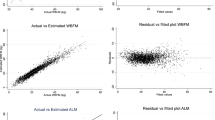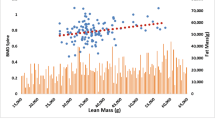Abstract
Objective
Lean body weight (LBW) decreases with age while total body fat increases, resulting in altered drug pharmacokinetics. A semi-mechanistic equation estimating LBW using height, weight and sex has been developed for potential use across a wide range of body compositions. The aim of this study was to determine the ability of the LBW equation to estimate dual energy x-ray absorptiometry-derived fat free mass (FFMDXA) in a population of older women with recent hip fracture.
Methods
Baseline, four and 12 month data obtained from 23 women enrolled in the Sarcopenia and Hip Fracture study were pooled to give 58 measurements. LBW was estimated using the equation:
Body composition was classified as: ‘normal’ (BMI <25kg/m2 and not sarcopenic), ‘overweight-obese’ (BMI >25kg/m2 and not sarcopenic), ‘sarcopenic’ (sarcopenic and BMI <25kg/m2), or ‘sarcopenic-obese’ (sarcopenic and BMI >25kg/m2). The ability of the LBW equation to predict FFMDXA was determined graphically using Bland-Altman plots and quantitatively using the method of Sheiner and Beal.
Results
The mean ± SD age of female participants women was 83±7 years (n=23). Sarcopenia was frequently observed (65.2%). Bland-Altman plots demonstrated an underestimation by the LBW equation compared to FFMDXA. The bias (95% CI) and precision (95% CI) calculated using the method of Sheiner and Beal was 0.5kg (−0.7, 1.66kg) and 4.4kg (−3.7, 12.4kg) respectively for pooled data.
Conclusion
This equation can be used to easily calculate LBW. When compared to FFMDXA, the LBW equation resulted in a small underestimation on average in this population of women with recent hip fracture. The degree of bias may not be clinically important although further studies of larger heterogeneous cohorts are needed to investigate and potentially improve the accuracy of this predictive equation in larger clinical cohorts.
Similar content being viewed by others
References
Forbes GB, Reina JC. Adult lean body mass declines with age: Some longitudinal observations. Metabolism 1970;19(9):653–663.
Roubenoff R. The pathophysiology of wasting in the elderly. Journal of Nutrition 1999;129(1S Suppl):256S–259S.
Bales CW, Ritchie CS. Sarcopenia, weight loss, and nutritional frailty in the elderly. Annual Review of Nutrition 2002;22:309–323.
Baumgartner RN, Wayne SJ, Waters DL, Janssen I, Gallagher D, Morley JE. Sarcopenic obesity predicts Instrumental Activities of Daily Living disability in the elderly. Obesity Research 2004;12(12):1995–2004.
Fried LP, Tangen CM, Walston J, Newman AB, Hirsch C, Gottdiener J, et al. Frailty in older adults: evidence for a phenotype. Journals of Gerontology Series ABiological Sciences & Medical Sciences 2001;56(3):M146–M156.
Morgan DJ, Bray KM. Lean body mass as a predictor of drug dosage. Implications for drug therapy. Clinical Pharmacokinetics 1994;26(4):292–307.
Roubenoff R, Kehayias JJ. The meaning and measurement of lean body mass. Nutrition Reviews 1991;49(6):163–175.
McPhail ME, Knowles RG, Salter M, Dawson J, Burchell B, Pogson CI. Uptake of acetaminophen (paracetamol) by isolated rat liver cells. Biochemical Pharmacology 1993;45(8):1599–1604.
Hansen RD, Raja C, Aslani A, Smith RC, Allen BJ. Determination of skeletal muscle and fat-free mass by nuclear and dual-energy X-ray absorptiometry methods in men and women aged 51–84 y. American Journal of Clinical Nutrition 1999;70(2):228–233.
Janmahasatian S, Duffull SB, Ash S, Ward LC, Byrne NM, Green B. Quantification of lean bodyweight. Clinical Pharmacokinetics 2005;44(10):1051–1065.
Hansen RD, Williamson DA, Finnegan TP, Lloyd BD, Grady JN, Diamond TH, et al. Estimation of thigh muscle cross-sectional area by dual-energy X-ray absorptiometry in frail elderly patients. American Journal of Clinical Nutrition 2007;86(4):952–958.
Han PY, Duffull SB, Kirkpatrick CM, Green B. Dosing in obesity: a simple solution to a big problem. Clinical Pharmacology & Therapeutics 2007;82(5):505–508.
Fiatarone Singh MA, Singh NA, Hansen RD, Finnegan TP, Allen BJ, Diamond TH, et al. Methodology and Baseline Characteristics for the Sarcopenia and Hip Fracture Study: A 5-Year Prospective Study. Journals of Gerontology Series A-Biological Sciences & Medical Sciences 2009;64A(5):568–574.
Hansen RD, Raja C, Baber RJ, Lieberman D, Allen BJ. Effects of 20-mg oestradiol implant therapy on bone mineral density, fat distribution and muscle mass in postmenopausal women. Acta Diabetologica 2003;40(0):s191–s195.
Madsen OR, Egsmose C, Lorentzen JS, Lauridsen UB, Sorensen OH. Influence of orthopaedic metal and high-density detection on body composition as assessed by dual-energy X-ray absorptiometry. Clinical Physiology 1999;19(3):238–245.
Giangregorio LM, Webber CE. Effects of metal implants on whole-body dual-energy x-ray absorptiometry measurements of bone mineral content and body composition. Canadian Association of Radiologists Journal-Journal De L Association Canadienne Des Radiologistes 2003;54(5):305–309.
Di Monaco M, Vallero F, Di Monaco R, Tappero R, Cavanna A. Muscle mass and functional recovery in women with hip fracture. American Journal of Physical Medicine & Rehabilitation 2006;85(3):209–215.
Di Monaco M, Vallero F, Di Monaco R, Tappero R, Cavanna A. Fat mass and skeletal muscle mass in hip-fracture women: A cross-sectional study. Maturitas 2007;56(4):404–410.
WHO. Obesity: preventing and managing the global epidemic. Report of a WHO consultation on obesity. Geneva: World Health Organization; 1998 3–5 June, 1997.
Castaneda C, Janssen I. Ethnic comparisons of sarcopenia and obesity in diabetes. Ethnicity & Disease 2005;15(4):664–670.
Bland JM, Altman DG. Statistical methods for assessing agreement between two methods of clinical measurement.[see comment]. Lancet 1986;1(8476):307–310.
Sheiner LB, Beal SL. Some suggestions for measuring predictive performance. Journal of Pharmacokinetics & Biopharmaceutics 1981;9(4):503–512.
Mitchell SJ, Kirkpatrick CMJ, Le Couteur DG, Naganathan V, Sambrook PN, Seibel MJ, et al. Estimation of lean body weight in older community dwelling men. British Journal of Clinical Pharmacology 2010;69(2):118–127.
Dey DK, Bosaeus I. Comparison of bioelectrical impedance prediction equations for fat-free mass in a population-based sample of 75 y olds: the NORA study. Nutrition 2003;19(10):858–864.
Deurenberg P, van der Kooy K, Hulshof T, Evers P. Body mass index as a measure of body fatness in the elderly. European Journal of Clinical Nutrition 1989;43(4):231–236.
Deurenberg P, Weststrate JA, Seidell JC. Body mass index as a measure of body fatness: age- and sex-specific prediction formulas. British Journal of Nutrition 1991;65(2):105–114.
Heitmann BL. Evaluation of body fat estimated from body mass index, skinfolds and impedance. A comparative study. European Journal of Clinical Nutrition 1990;44(11):831–837.
McLean AJ, Le Couteur DG. Aging biology and geriatric clinical pharmacology. Pharmacological Reviews 2004;56(2):163–184.
Gallagher D, Ruts E, Visser M, Heshka S, Baumgartner RN, Wang J, et al. Weight stability masks sarcopenia in elderly men and women. American Journal of Physiology — Endocrinology & Metabolism 2000;279(2):E366–E375.
Jarosz PA, Bellar A. Sarcopenic Obesity: An Emerging Cause of Frailty in Older Adults. Geriatric Nursing 2009;30(1):64–70.
Author information
Authors and Affiliations
Rights and permissions
About this article
Cite this article
Mitchell, S.J., Hilmer, S.N., Kirkpatrick, C.M.J. et al. Estimation of lean body weight in older women with hip fracture. J Nutr Health Aging 16, 188–192 (2012). https://doi.org/10.1007/s12603-011-0100-y
Received:
Accepted:
Published:
Issue Date:
DOI: https://doi.org/10.1007/s12603-011-0100-y




